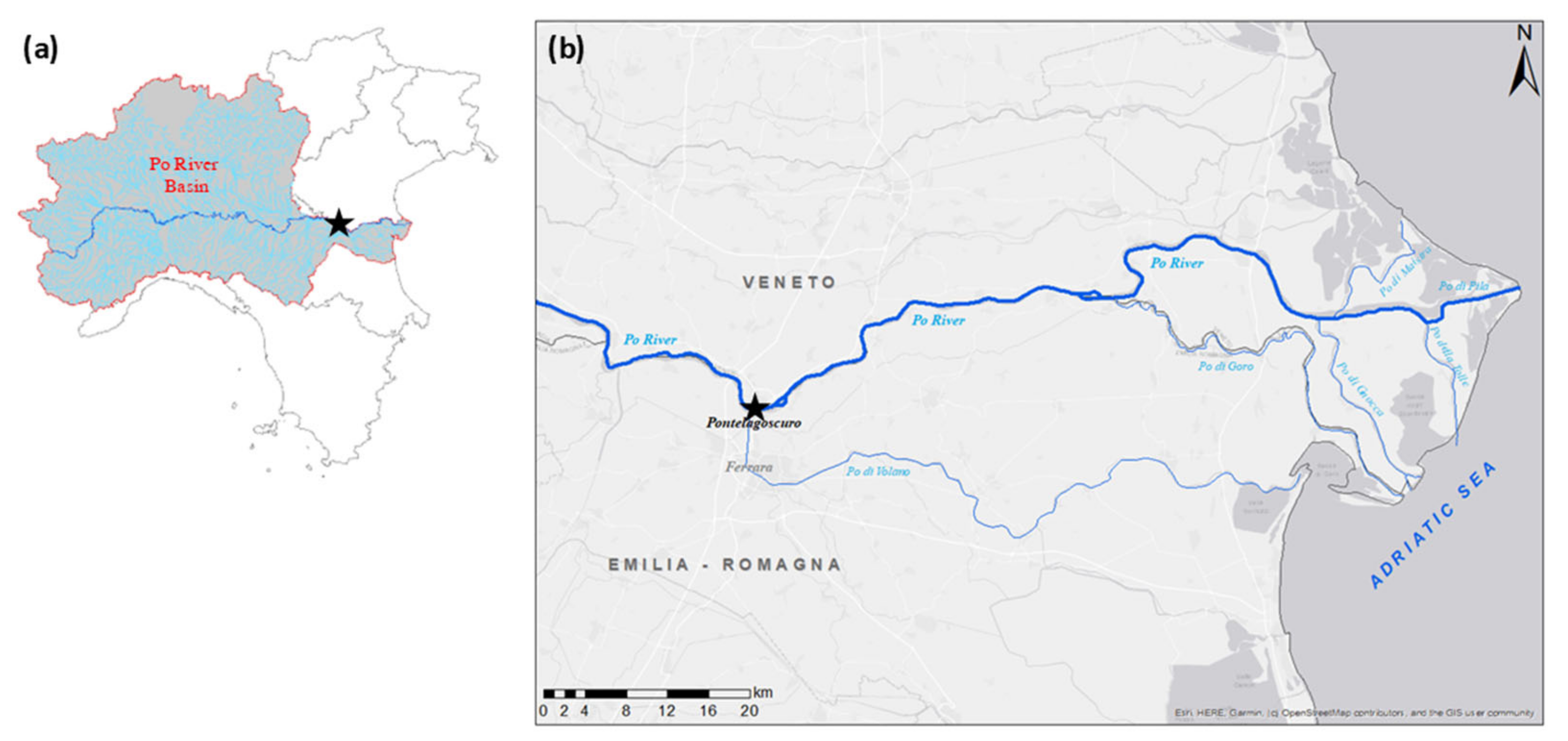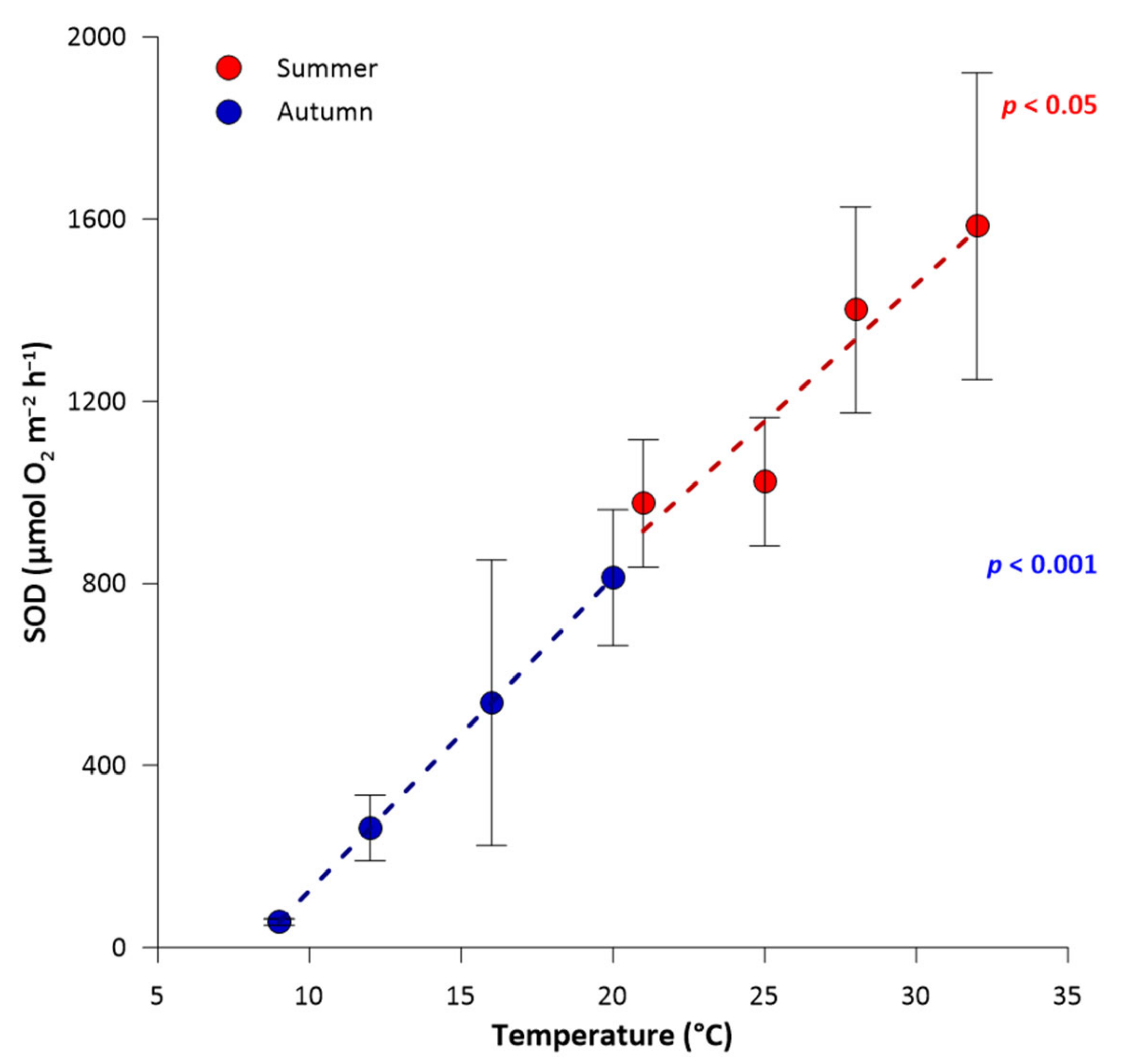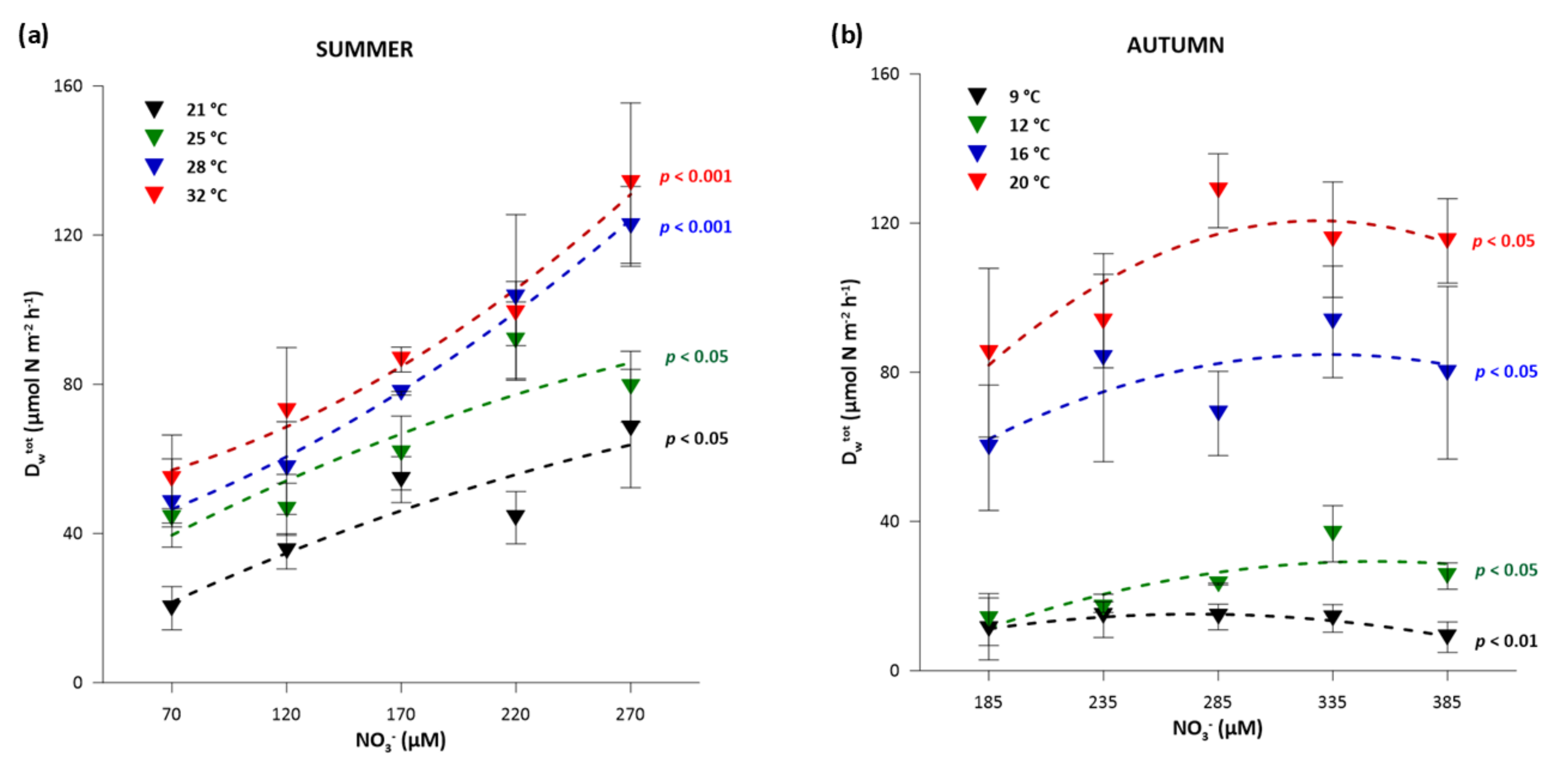The Response of Denitrification to Increasing Water Temperature and Nitrate Availability: The Case of a Large Lowland River (Po River, Northern Italy) under a Climate Change Scenario
Abstract
:1. Introduction
2. Materials and Methods
2.1. Study Area and Sampling Procedure
2.2. Measurement of Benthic Oxygen Fluxes along Temperature Gradients
2.3. Measurement of Denitrification along Temperature and NO3− Gradients
2.4. Sediment Characterization
2.5. Statistical Analysis
3. Results and Discussion
3.1. River Sediment Oxygen Demand along Seasonal Temperature Gradients
3.2. Influence of Water Temperature and NO3− Concentration on Partitioning between Dw and Dn
3.3. Climate Change-Related Factors Controlling Denitrification
4. Conclusions
Author Contributions
Funding
Data Availability Statement
Acknowledgments
Conflicts of Interest
References
- IPCC. IPCC, 2021: Climate Change 2021: The Physical Science Basis. Contribution of Working Group I to the Sixth Assessment Report of the Intergovernmental Panel on Climate Change; Cambridge University Press: Cambridge, UK, 2021. [Google Scholar]
- Whitehead, P.G.; Wilby, R.L.; Battarbee, R.W.; Kernan, M.; Wade, A.J. A Review of the Potential Impacts of Climate Change on Surface Water Quality. Hydrol. Sci. J. 2009, 54, 101–123. [Google Scholar] [CrossRef]
- Zhao, G.; Merder, J.; Ballard, T.C.; Michalak, A.M. Warming May Offset Impact of Precipitation Changes on Riverine Nitrogen Loading. Proc. Natl. Acad. Sci. USA 2023, 120, e2220616120. [Google Scholar] [CrossRef] [PubMed]
- Liu, S.; Hu, K.; Xie, Z.; Wang, Y. Seasonal Constraint of Dynamic Water Temperature on Riverine Dissolved Inorganic Nitrogen Transport in Land Surface Modeling. Atmos. Ocean. Sci. Lett. 2024, 17, 100485. [Google Scholar] [CrossRef]
- Gao, Y.; Zhu, B.; Yu, G.; Chen, W.; He, N.; Wang, T.; Miao, C. Coupled Effects of Biogeochemical and Hydrological Processes on C, N, and P Export during Extreme Rainfall Events in a Purple Soil Watershed in Southwestern China. J. Hydrol. 2014, 511, 692–702. [Google Scholar] [CrossRef]
- Ballard, T.C.; Sinha, E.; Michalak, A.M. Long-Term Changes in Precipitation and Temperature Have Already Impacted Nitrogen Loading. Environ. Sci. Technol. 2019, 53, 5080–5090. [Google Scholar] [CrossRef]
- Van Vliet, M.T.H.; Thorslund, J.; Strokal, M.; Hofstra, N.; Flörke, M.; Ehalt Macedo, H.; Nkwasa, A.; Tang, T.; Kaushal, S.S.; Kumar, R.; et al. Global River Water Quality under Climate Change and Hydroclimatic Extremes. Nat. Rev. Earth Environ. 2023, 4, 687–702. [Google Scholar] [CrossRef]
- Piña-Ochoa, E.; Álvarez-Cobelas, M. Denitrification in Aquatic Environments: A Cross-System Analysis. Biogeochemistry 2006, 81, 111–130. [Google Scholar] [CrossRef]
- Birgand, F.; Skaggs, R.W.; Chescheir, G.M.; Gilliam, J.W. Nitrogen Removal in Streams of Agricultural Catchments—A Literature Review. Crit. Rev. Environ. Sci. Technol. 2007, 37, 381–487. [Google Scholar] [CrossRef]
- Zhao, S.; Zhang, B.; Sun, X.; Yang, L. Hot Spots and Hot Moments of Nitrogen Removal from Hyporheic and Riparian Zones: A Review. Sci. Total Environ. 2021, 762, 144168. [Google Scholar] [CrossRef]
- Knowles, R. Denitrification. Microbiol. Rev. 1982, 46, 43–70. [Google Scholar] [CrossRef]
- Seitzinger, S.; Harrison, J.A.; Böhlke, J.K.; Bouwman, A.F.; Lowrance, R.; Peterson, B.; Tobias, C.; Drecht, G.V. Denitrification across landscapes and waterscapes: A synthesis. Ecol. Appl. 2006, 16, 2064–2090. [Google Scholar] [CrossRef] [PubMed]
- Wallenstein, M.D.; Myrold, D.D.; Firestone, M.; Voytek, M. Environmental controls on denitrifying communities and denitrification rates: Insights from molecular methods. Ecol. Appl. 2006, 16, 2143–2152. [Google Scholar] [CrossRef] [PubMed]
- Silvennoinen, H.; Liikanen, A.; Torssonen, J.; Stange, C.F.; Martikainen, P.J. Denitrification and N2O Effluxes in the Bothnian Bay (Northern Baltic Sea) River Sediments as Affected by Temperature under Different Oxygen Concentrations. Biogeochemistry 2008, 88, 63–72. [Google Scholar] [CrossRef]
- Jickells, T.D.; Weston, K. Nitrogen Cycle—External Cycling. In Treatise on Estuarine and Coastal Science; Elsevier: Amsterdam, The Netherlands, 2011; pp. 261–278. ISBN 978-0-08-087885-0. [Google Scholar]
- Lu, C.; Zhang, J.; Tian, H.; Crumpton, W.G.; Helmers, M.J.; Cai, W.-J.; Hopkinson, C.S.; Lohrenz, S.E. Increased Extreme Precipitation Challenges Nitrogen Load Management to the Gulf of Mexico. Commun. Earth Environ. 2020, 1, 21. [Google Scholar] [CrossRef]
- Soana, E.; Gervasio, M.P.; Granata, T.; Colombo, D.; Castaldelli, G. Climate Change Impacts on Eutrophication in the Po River (Italy): Temperature-Mediated Reduction in Nitrogen Export but No Effect on Phosphorus. J. Environ. Sci. 2024, 143, 148–163. [Google Scholar] [CrossRef]
- Gervasio, M.P.; Soana, E.; Granata, T.; Colombo, D.; Castaldelli, G. An Unexpected Negative Feedback between Climate Change and Eutrophication: Higher Temperatures Increase Denitrification and Buffer Nitrogen Loads in the Po River (Northern Italy). Environ. Res. Lett. 2022, 17, 084031. [Google Scholar] [CrossRef]
- Pavan, V.; Antolini, G.; Barbiero, R.; Berni, N.; Brunier, F.; Cacciamani, C.; Cagnati, A.; Cazzuli, O.; Cicogna, A.; De Luigi, C.; et al. High Resolution Climate Precipitation Analysis for North-Central Italy, 1961–2015. Clim. Dyn. 2019, 52, 3435–3453. [Google Scholar] [CrossRef]
- Persiano, S.; Ferri, E.; Antolini, G.; Domeneghetti, A.; Pavan, V.; Castellarin, A. Changes in Seasonality and Magnitude of Sub-Daily Rainfall Extremes in Emilia-Romagna (Italy) and Potential Influence on Regional Rainfall Frequency Estimation. J. Hydrol. Reg. Stud. 2020, 32, 100751. [Google Scholar] [CrossRef]
- Soana, E.; Bartoli, M.; Milardi, M.; Fano, E.A.; Castaldelli, G. An Ounce of Prevention Is Worth a Pound of Cure: Managing Macrophytes for Nitrate Mitigation in Irrigated Agricultural Watersheds. Sci. Total Environ. 2019, 647, 301–312. [Google Scholar] [CrossRef]
- Ludwig, W.; Dumont, E.; Meybeck, M.; Heussner, S. River Discharges of Water and Nutrients to the Mediterranean and Black Sea: Major Drivers for Ecosystem Changes during Past and Future Decades? Prog. Oceanogr. 2009, 80, 199–217. [Google Scholar] [CrossRef]
- Blaas, H.; Kroeze, C. Excessive Nitrogen and Phosphorus in European Rivers: 2000–2050. Ecol. Indic. 2016, 67, 328–337. [Google Scholar] [CrossRef]
- Grilli, F.; Accoroni, S.; Acri, F.; Bernardi Aubry, F.; Bergami, C.; Cabrini, M.; Campanelli, A.; Giani, M.; Guicciardi, S.; Marini, M.; et al. Seasonal and Interannual Trends of Oceanographic Parameters over 40 Years in the Northern Adriatic Sea in Relation to Nutrient Loadings Using the EMODnet Chemistry Data Portal. Water 2020, 12, 2280. [Google Scholar] [CrossRef]
- Montanari, A.; Nguyen, H.; Rubinetti, S.; Ceola, S.; Galelli, S.; Rubino, A.; Zanchettin, D. Why the 2022 Po River Drought Is the Worst in the Past Two Centuries. Sci. Adv. 2023, 9, eadg8304. [Google Scholar] [CrossRef]
- Bonaldo, D.; Bellafiore, D.; Ferrarin, C.; Ferretti, R.; Ricchi, A.; Sangelantoni, L.; Vitelletti, M.L. The Summer 2022 Drought: A Taste of Future Climate for the Po Valley (Italy)? Reg. Environ. Chang. 2023, 23, 1. [Google Scholar] [CrossRef]
- Gervasio, M.P.; Soana, E.; Vincenzi, F.; Magri, M.; Castaldelli, G. Drought-Induced Salinity Intrusion Affects Nitrogen Removal in a Deltaic Ecosystem (Po River Delta, Northern Italy). Water 2023, 15, 2405. [Google Scholar] [CrossRef]
- Gervasio, M.P.; Soana, E.; Gavioli, A.; Vincenzi, F.; Castaldelli, G. Contrasting Effects of Climate Change on Denitrification and Nitrogen Load Reduction in the Po River (Northern Italy). Environ. Sci. Pollut. Res. 2024, 31, 48189–48204. [Google Scholar] [CrossRef]
- Vezzoli, R.; Mercogliano, P.; Pecora, S.; Zollo, A.L.; Cacciamani, C. Hydrological Simulation of Po River (North Italy) Discharge under Climate Change Scenarios Using the RCM COSMO-CLM. Sci. Total Environ. 2015, 521–522, 346–358. [Google Scholar] [CrossRef]
- Dalsgaard, T.; Nielsen, L.P.; Brotas, V.; Viaroli, P.; Underwood, G.; Nedwell, D.; Sundback, K.; Rysgaard, S.; Miles, A.; Bartoli, M.; et al. Protocol Handbook for NICE-Nitrogen Cycling in Estuaries: A Project under the EU Research Programme: Marine Science and Technology (MAST III); Ministry of Environment and Energy National Environmental Research Institute: Silkeborg, Denmark; Department of Lake and Estuarine Ecology: Silkeborg, Denmark, 2000; pp. 1–62.
- Owens, M.S.; Cornwell, J.C. The Benthic Exchange of O2, N2 and Dissolved Nutrients Using Small Core Incubations. J. Vis. Exp. 2016, 104, 54098. [Google Scholar] [CrossRef]
- Braga, F.; Zaggia, L.; Bellafiore, D.; Bresciani, M.; Giardino, C.; Lorenzetti, G.; Maicu, F.; Manzo, C.; Riminucci, F.; Ravaioli, M.; et al. Mapping Turbidity Patterns in the Po River Prodelta Using Multi-Temporal Landsat 8 Imagery. Estuar. Coast. Shelf Sci. 2017, 198, 555–567. [Google Scholar] [CrossRef]
- Nielsen, L.P. Denitrification in Sediment Determined from Nitrogen Isotope Pairing. FEMS Microbiol. Lett. 1992, 86, 357–362. [Google Scholar] [CrossRef]
- Boldrin, A.; Langone, L.; Miserocchi, S.; Turchetto, M.; Acri, F. Po River Plume on the Adriatic Continental Shelf: Dispersion and Sedimentation of Dissolved and Suspended Matter during Different River Discharge Rates. Mar. Geol. 2005, 222–223, 135–158. [Google Scholar] [CrossRef]
- Menicucci, S.; De Felice, A.; Biagiotti, I.; Canduci, G.; Costantini, I.; Palermino, A.; Centurelli, M.; Leonori, I. Interannual Variation in the Zooplankton Community of the North Adriatic Sea under Short-Term Climatic Anomalies. Diversity 2024, 16, 291. [Google Scholar] [CrossRef]
- Armstrong, F.A.J.; Stearns, C.R.; Strickland, J.D.H. The Measurement of Upwelling and Subsequent Biological Process by Means of the Technicon Autoanalyzer® and Associated Equipment. Deep. Sea Res. Oceanogr. Abstr. 1967, 14, 381–389. [Google Scholar] [CrossRef]
- Kana, T.M.; Darkangelo, C.; Hunt, M.D.; Oldham, J.B.; Bennett, G.E.; Cornwell, J.C. Membrane Inlet Mass Spectrometer for Rapid High-Precision Determination of N2, O2, and Ar in Environmental Water Samples. Anal. Chem. 1994, 66, 4166–4170. [Google Scholar] [CrossRef]
- Robertson, E.K.; Bartoli, M.; Brüchert, V.; Dalsgaard, T.; Hall, P.O.J.; Hellemann, D.; Hietanen, S.; Zilius, M.; Conley, D.J. Application of the Isotope Pairing Technique in Sediments: Use, Challenges, and New Directions. Limnol. Ocean Methods 2019, 17, 112–136. [Google Scholar] [CrossRef]
- Steingruber, S.M.; Friedrich, J.; Gächter, R.; Wehrli, B. Measurement of Denitrification in Sediments with the 15N Isotope Pairing Technique. Appl. Environ. Microbiol. 2001, 67, 3771–3778. [Google Scholar] [CrossRef]
- Eyre, B.D.; Rysgaard, S.; Dalsgaard, T.; Christensen, P.B. Comparison of Isotope Pairing and N2:Ar Methods for Measuring Sediment Denitrification—Assumption, Modifications, and Implications. Estuaries 2002, 25, 1077–1087. [Google Scholar] [CrossRef]
- Pinheiro, J.; Bates, D.; DebRoy, S.; Sarkar, D.; R Core Team. nlme: Linear and Nonlinear Mixed Effects Models. R Package Version 2018, 3, 1–137. [Google Scholar]
- Deichmann, U.; Schuster, S.; Mazat, J.; Cornish-Bowden, A. Commemorating the 1913 Michaelis–Menten Paper Die Kinetik Der Invertinwirkung: Three Perspectives. FEBS J. 2014, 281, 435–463. [Google Scholar] [CrossRef]
- De Klein, J.J.M.; Overbeek, C.C.; Juncher Jørgensen, C.; Veraart, A.J. Effect of Temperature on Oxygen Profiles and Denitrification Rates in Freshwater Sediments. Wetlands 2017, 37, 975–983. [Google Scholar] [CrossRef]
- Johnson, M.F.; Albertson, L.K.; Algar, A.C.; Dugdale, S.J.; Edwards, P.; England, J.; Gibbins, C.; Kazama, S.; Komori, D.; MacColl, A.D.C.; et al. Rising Water Temperature in Rivers: Ecological Impacts and Future Resilience. WIREs Water 2024, 11, e1724. [Google Scholar] [CrossRef]
- Perkins, D.M.; Yvon-Durocher, G.; Demars, B.O.L.; Reiss, J.; Pichler, D.E.; Friberg, N.; Trimmer, M.; Woodward, G. Consistent Temperature Dependence of Respiration across Ecosystems Contrasting in Thermal History. Glob. Chang. Biol. 2012, 18, 1300–1311. [Google Scholar] [CrossRef]
- Saunders, D.L.; Kalff, J. Nitrogen Retention in Wetlands, Lakes and Rivers. Hydrobiologia 2001, 443, 205–212. [Google Scholar] [CrossRef]
- Boulêtreau, S.; Lyautey, E.; Dubois, S.; Compin, A.; Delattre, C.; Touron-Bodilis, A.; Mastrorillo, S.; Garabetian, F. Warming-Induced Changes in Denitrifier Community Structure Modulate the Ability of Phototrophic River Biofilms to Denitrify. Sci. Total Environ. 2014, 466–467, 856–863. [Google Scholar] [CrossRef] [PubMed]
- Velthuis, M.; Veraart, A.J. Temperature Sensitivity of Freshwater Denitrification and N2O Emission—A Meta-Analysis. Glob. Biogeochem. Cycles 2022, 36, e2022GB007339. [Google Scholar] [CrossRef]
- Speir, S.L.; Tank, J.L.; Taylor, J.M.; Grose, A.L. Temperature and Carbon Availability Interact to Enhance Nitrous Oxide Production via Denitrification in Alluvial Plain River Sediments. Biogeochemistry 2023, 165, 191–203. [Google Scholar] [CrossRef]
- Veraart, A.J.; De Klein, J.J.M.; Scheffer, M. Warming Can Boost Denitrification Disproportionately Due to Altered Oxygen Dynamics. PLoS ONE 2011, 6, e18508. [Google Scholar] [CrossRef]
- Ward, B.B. Nitrification: An Introduction and Overview of the State of the Field. In Nitrification; Ward, B.B., Arp, D.J., Klotz, M.G., Eds.; ASM Press: Washington, DC, USA, 2014; pp. 1–8. ISBN 978-1-68367-116-9. [Google Scholar]
- Qu, W.; Suo, L.; Liu, R.; Liu, M.; Zhao, Y.; Xia, L.; Fan, Y.; Zhang, Q.; Gao, Z. Influence of Temperature on Denitrification and Microbial Community Structure and Diversity: A Laboratory Study on Nitrate Removal from Groundwater. Water 2022, 14, 436. [Google Scholar] [CrossRef]
- Brin, L.D.; Giblin, A.E.; Rich, J.J. Similar Temperature Responses Suggest Future Climate Warming Will Not Alter Partitioning between Denitrification and Anammox in Temperate Marine Sediments. Glob. Chang. Biol. 2017, 23, 331–340. [Google Scholar] [CrossRef]
- Verstraete, W.; Forcht, D.D. Biochemical Ecology of Nitrification and Denitrification [Soils]. In Advances in Microbial Ecology; Springer: Boston, MA, USA, 1977; pp. 135–214. [Google Scholar]
- Nogaro, G.; Burgin, A.J. Influence of Bioturbation on Denitrification and Dissimilatory Nitrate Reduction to Ammonium (DNRA) in Freshwater Sediments. Biogeochemistry 2014, 120, 279–294. [Google Scholar] [CrossRef]
- Racchetti, E.; Bartoli, M.; Soana, E.; Longhi, D.; Christian, R.R.; Pinardi, M.; Viaroli, P. Influence of Hydrological Connectivity of Riverine Wetlands on Nitrogen Removal via Denitrification. Biogeochemistry 2011, 103, 335–354. [Google Scholar] [CrossRef]
- Inwood, S.E.; Tank, J.L.; Bernot, M.J. Factors Controlling Sediment Denitrification in Midwestern Streams of Varying Land Use. Microb. Ecol. 2007, 53, 247–258. [Google Scholar] [CrossRef] [PubMed]
- Soana, E.; Naldi, M.; Bonaglia, S.; Racchetti, E.; Castaldelli, G.; Brüchert, V.; Viaroli, P.; Bartoli, M. Benthic Nitrogen Metabolism in a Macrophyte Meadow (Vallisneria spiralis L.) under Increasing Sedimentary Organic Matter Loads. Biogeochemistry 2015, 124, 387–404. [Google Scholar] [CrossRef]
- Tesi, T.; Miserocchi, S.; Acri, F.; Langone, L.; Boldrin, A.; Hatten, J.A.; Albertazzi, S. Flood-Driven Transport of Sediment, Particulate Organic Matter, and Nutrients from the Po River Watershed to the Mediterranean Sea. J. Hydrol. 2013, 498, 144–152. [Google Scholar] [CrossRef]
- Stelzer, R.S.; Thad Scott, J.; Bartsch, L.A.; Parr, T.B. Particulate Organic Matter Quality Influences Nitrate Retention and Denitrification in Stream Sediments: Evidence from a Carbon Burial Experiment. Biogeochemistry 2014, 119, 387–402. [Google Scholar] [CrossRef]
- Seitzinger, S. Linkages between Organic Matter Mineralization and Denitrification in Eight Riparian Wetlands. Biogeochemistry 1994, 25, 19–39. [Google Scholar] [CrossRef]





| Seasons | Temperature (°C) | O2 (mg L−1) | NO3− (µM) | OM (%) | Density (g mL−1) | Porosity (%) |
|---|---|---|---|---|---|---|
| Summer | 29 | 8.3 | 20 (2) | 0.4 (0.03) | 2.1 (0.1) | 40 (3) |
| Autumn | 14 | 10.2 | 135 (3) | 1.7 (0.4) | 1.8 (0.2) | 60 (10) |
| Season | Temperature (°C) | 15NO3− (µM) | Temperature × 15NO3− | |||
|---|---|---|---|---|---|---|
| F | p | F | p | F | p | |
| Summer | 33.0 | <0.001 | 115.7 | <0.001 | 3.6 | 0.05 |
| Autumn | 202.3 | <0.001 | 51.6 | <0.001 | 32.6 | <0.001 |
Disclaimer/Publisher’s Note: The statements, opinions and data contained in all publications are solely those of the individual author(s) and contributor(s) and not of MDPI and/or the editor(s). MDPI and/or the editor(s) disclaim responsibility for any injury to people or property resulting from any ideas, methods, instructions or products referred to in the content. |
© 2024 by the authors. Licensee MDPI, Basel, Switzerland. This article is an open access article distributed under the terms and conditions of the Creative Commons Attribution (CC BY) license (https://creativecommons.org/licenses/by/4.0/).
Share and Cite
Gervasio, M.P.; Castaldelli, G.; Soana, E. The Response of Denitrification to Increasing Water Temperature and Nitrate Availability: The Case of a Large Lowland River (Po River, Northern Italy) under a Climate Change Scenario. Environments 2024, 11, 179. https://doi.org/10.3390/environments11080179
Gervasio MP, Castaldelli G, Soana E. The Response of Denitrification to Increasing Water Temperature and Nitrate Availability: The Case of a Large Lowland River (Po River, Northern Italy) under a Climate Change Scenario. Environments. 2024; 11(8):179. https://doi.org/10.3390/environments11080179
Chicago/Turabian StyleGervasio, Maria Pia, Giuseppe Castaldelli, and Elisa Soana. 2024. "The Response of Denitrification to Increasing Water Temperature and Nitrate Availability: The Case of a Large Lowland River (Po River, Northern Italy) under a Climate Change Scenario" Environments 11, no. 8: 179. https://doi.org/10.3390/environments11080179







